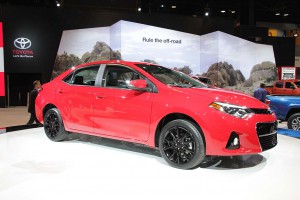With auto sales expected to increase in key market around the world, Toyota is apparently looking to expand its capacity by building new assembly plants in China and Mexico.
Press reports from Tokyo said that the Japanese auto giant anticipates investing $1.3 billion to build the new plants – a move that would reverse a ban on new factories imposed by Chairman Akio Toyoda when he took over as the company’s top executive.
Just last week, senior Toyota officials announced the first part of their new growth plan, dubbed Toyota New Global Architecture, or TNGA. The use of the word was fitting, analysts noted, because a key step will be the introduction of new vehicle architectures, or platforms for at least half of its vehicles by 2020.
It is a similar step to what key rivals has done with platforms such as the MQB architecture that will soon to serve about half of the products sold by its dozen passenger car brands. The approach is seen as a way to improve economies of scale, expand the range of product offerings – and get a bitter grip on quality.
(For more on Toyota’s TNGA plan, Click Here.)
Chairman Toyoda, the grandson of the automaker’s parent had put new plant construction on hold after Toyota stumbled in the wake of major growth spurt a decade ago. Industry analysts blamed the carmaker’s opening of new plants at a record pace for some embarrassing quality and safety-related problems.
And while Toyota gained enough new capacity to surge past rival General Motors to become the world’s largest automaker in 2008, it also was encumbered with excess capacity during the depths of the recession.
(Toyota unveils new RAV4 Hybrid at NY Auto Show. Click Here to check it out.)
Now, however, Toyota believes it needs more capacity to keep up with surging demand, especially in emerging markets. It is also facing a challenge from VW which has laid out plans to become the world’s largest automaker by 2018.
Significantly, VW has a strong lead over Toyota in the world’s largest car market, China. The new plants could raise Toyota’s annual production capacity by nearly 300,000 cars, according to a dispatch from Reuters, including 100,000 in China, and another 200,000 in Mexico.
The renewed expansion drive could help Toyota fend off rivals GM and VW, which have used success in China to help challenge the Japanese automaker’s grip on the number one ranking. But if the current reports are accurate, Toyota would still lag by a wide margin the production capacity its rivals already have in the booming Asian market.
Due to long-standing enmity between the two countries – worsened in the wake of a political dispute over ownership of a chain of unpopulated islands – Japanese car sales in China have lagged in recent years.
Following GM and VW’s rapid expansion in China over the past decade, each of the three auto giants now have the capacity to build more than 10 million vehicles annually and the figure is being constantly adjusted upwards.
Analysts, however, fear another round of capacity expansion by the global automakers would leave the industry saddled with excess capacity.
Not everyone agrees, what with forecasts calling for global car sales to reach 100 million or more annually withing the coming decade. Renault-Nissan Alliance CEO Carlos Ghosn last week said the company needs more capacity if it is going to continue to expand. And Daimler AG has confirmed it is now currently searching for a site where it could build a luxury pickup trucks that would be sold in a wide variety of markets around the world.
(Nissan needs more capacity; US factory may be in works, hints Ghosn. Click Here to learn more.)
Toyota’s plans are expected to call for building the next-generation Corolla sedan for the North American market in Mexico starting in 2019 and 100,000 Yaris subcompacts in Guangzhou, starting in 2018.
The choice of Mexico also comes as little surprise as it is rapidly becoming one of the world’s largest sources of vehicle production due to low labor costs and a large number of international free trade agreements. Honda recently expanded production in Mexico, as did Japanese rival Nissan. That latter maker plans to further increase capacity at a plant in Aguascalientes where it will be joined by Daimler to produce an assortment of Mercedes-Benz and Infiniti models.
(Paul A. Eisenstein contributed to this report.)

